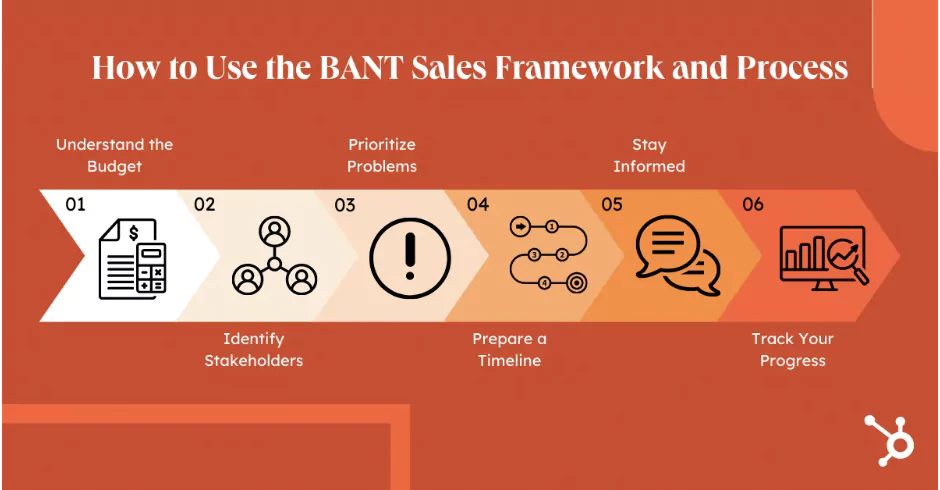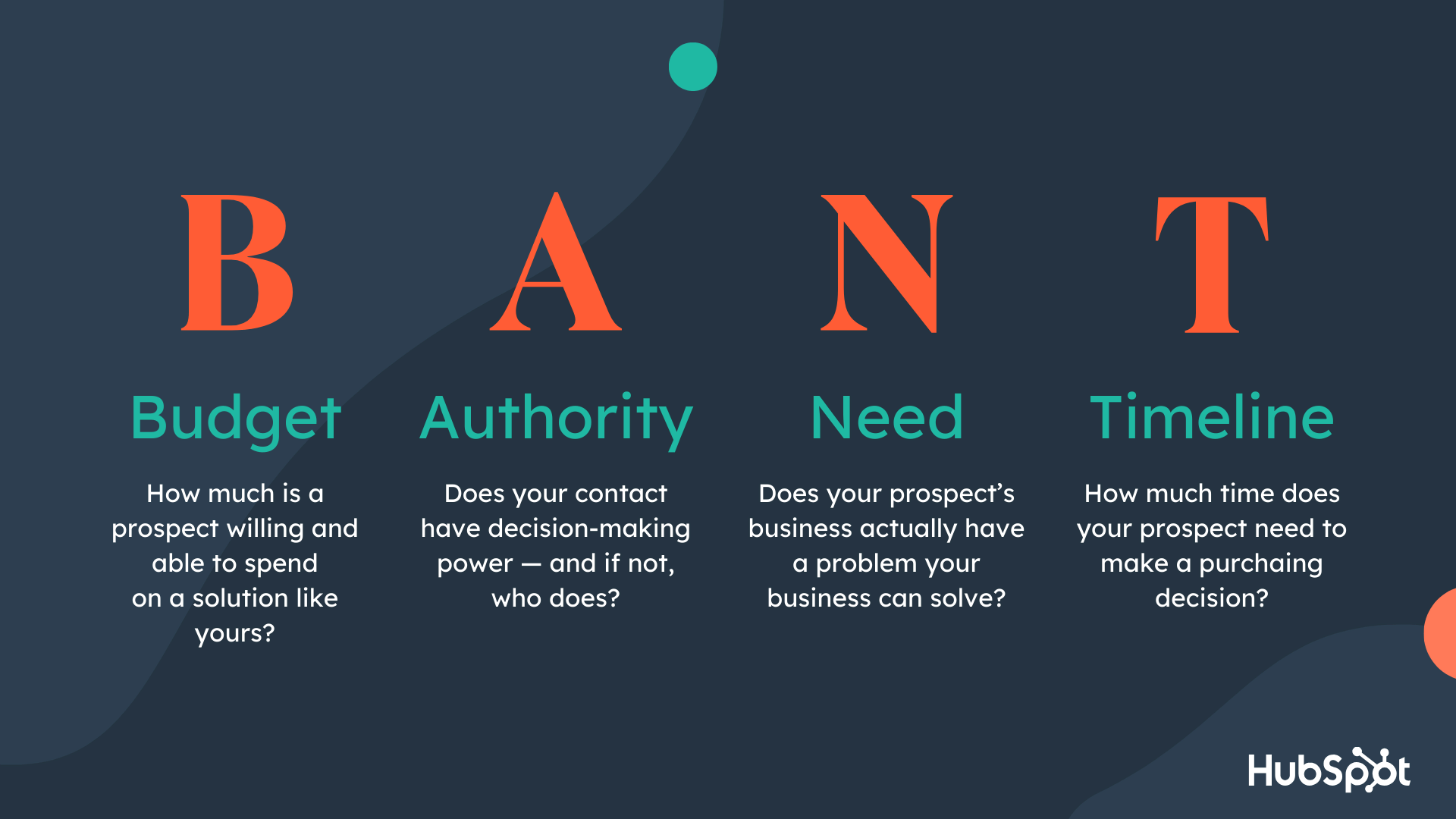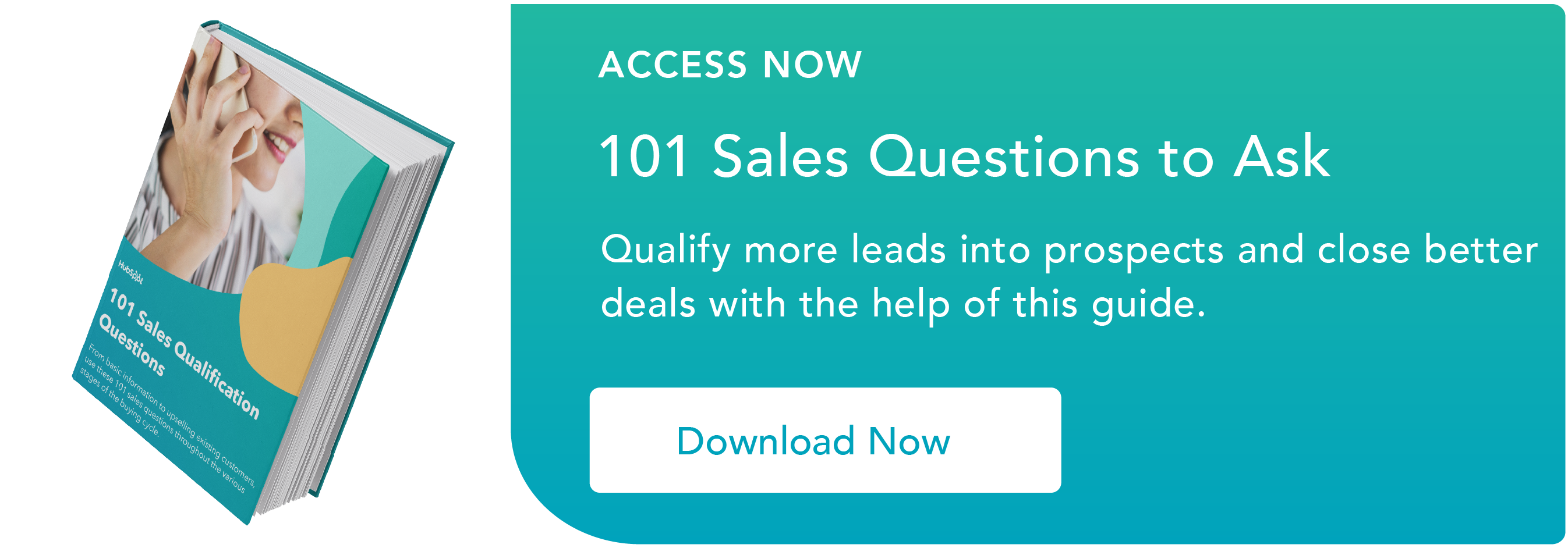Ask virtually any salesperson, and they‘ll tell you that lead qualification is one of the field’s trickiest, most delicate responsibilities. Not every prospect has the interest, urgency, and ability to buy a solution like yours — so asking the right questions to uncover whether a deal has legitimate potential is every bit as finicky as it is necessary. That's where qualification frameworks like BANT come in.

It's one of the most (if not the most) popular sales qualification methodologies — letting you get insight into whether a contact has the necessary budget, authority, need, and timeline to make a sales engagement worth your time, effort, and resources.
Here, we'll get a clearer picture of what BANT is, how to use it, how not to use it, and some key BANT questions you can ask to ensure that your lead qualification is as seamless and effective as possible.
Table of Contents
- What is BANT?
- What does BANT stand for?
- How to Use the BANT Sales Framework and Process
- How Not to Use BANT
- BANT Lead Qualification Questions
What is BANT?
BANT is a sales qualification methodology that helps salespeople determine whether a prospect is a good fit based on their budget, internal influence/ability to buy, need for the product, and purchase timeline.
BANT was first developed by IBM in the 1950s and is now included as part of the company’s Business Agility Solution Identification Guide. It worked well for the company and others that adopted it because it made the sales process more efficient.
From the company’s perspective, the sales reps could learn all the pertinent information upfront to determine if the prospect was a good fit for its products. If the prospect was not a fit, they would be disqualified from the sales process.
Companies like IBM used BANT to quickly qualify leads, making more of their time available for selling to qualified prospects.
What does BANT stand for?
The acronym BANT stands for: budget — how much money the prospect is able and willing to spend; authority — the ultimate decision-maker; need — whether the prospect has a problem your business can solve; and, timing — whether there is urgency to purchase your product or service.
BANT‘s definition is pretty clear cut — so while how you execute on the framework will involve some finesse, creativity, and a sense of how your prospect is responding to your questions, you’ll ultimately need to cover the following aspects:
Budget - How much is the prospect willing and able to spend on your solution?
Authority - Who is the authority figure in this sale? Who makes the ultimate decision?
Need - Does the prospect have a true need for my product? Is this a universal need on the team?
Timeline - How much time will the prospect need to make a purchasing decision?
BANT is a staple of several orgs‘ sales processes — offering a thoughtfully structured, efficient roadmap to help sales reps qualify leads during discovery. It provides a more streamlined path for understanding a prospect’s purchase potential and intent than most lead-scoring methods.
Instead of waiting days or weeks to qualify leads by assigning scores based on how a prospect engages with marketing and sales materials, BANT gives salespeople immediate and valuable perspective on whether a prospect has the resources, interest, and ability to buy.
How to Use the BANT Sales Framework and Process
- Understand the prospect’s budget beyond the dollar amount.
- Identify stakeholders in the decision-making process.
- Determine the importance of the problem.
- Prepare a timeline for the sales process.
- Stay informed through multiple channels.
- Use digital tools to track your progress.

1. Understand the prospect’s budget beyond the dollar amount.
When sales reps were primarily selling licenses in the old days, qualifying based on financial need was a bit more straightforward — but in the era of the modern, empowered buyer and the more elaborate pricing models several companies offer to suit them, the “budget” element of BANT isn't necessarily cut-and-dry.
Strategies like subscription pricing make selling on budget a much more dynamic process than it used to be. Several B2B SaaS companies, for example, charge anywhere from $10 for basic plans to tens of thousands of dollars per month for enterprise options.
That kind of range can make qualifying or disqualifying a prospect based on budget a bit more flexible and often considerably more complex. So when addressing the “B” of BANT, you want to try to get your prospect to see their budget as less of a concrete figure and a potential hard stop.
Pro-Tip: Ask about the prospect‘s expected ROI — if it aligns with what your solution can offer, sell based on that. Give them perspective on the financial outcome they can expect to see more so than the upfront cost that they’ll need to put up.
Obviously, if the discrepancy between their allotted budget and expected ROI is unreasonable, you can disqualify — the same goes if they're stuck on a price point that is way beyond what you can reasonably accommodate.
2. Identify stakeholders in the decision-making process.
Virtually everyone in sales already knows this, but it bears repeating — almost every B2B deal involves multiple stakeholders. Even if one person is responsible for signing the contract, you'll likely need buy-in from at least a few more.
You need to keep tabs on everyone who's going to be involved in a potential purchase — that means knowing their job titles, degree of decision-making authority, priorities, and how you can get access to them (whether that be asking your champion to set up a meeting, reaching out to them directly, or any other reasonable avenue you can find to be able to connect with them).
You have to know if you‘re talking to the right person — the “A” in BANT is there for a reason. Your champion could be a gold medalist, but if they don’t have the leverage or authority to meaningfully sway their company's ultimate decision, you might need to ask for a referral up the chain of command.
3. Determine the importance of the problem.
Next, figure out how important this problem is to the prospect. While you’re asking your prospect the questions we recommended earlier, ask yourself the following questions: Are they highly motivated to solve it? What happens if they don’t? Is there a different initiative they care about more that will compete for their energy, attention, and decision-making capital?
A prospect might say they have a particular need and may very well mean it, but the team’s or executive leadership’s priorities may be different. This will inevitably cause kinks in the sales process down the road. Do your best to uncover your prospect, team, and leaders' needs as early as possible.
4. Prepare a timeline for the sales process.
You know the budget, who the decision-makers are, and the need they have for your product. Now it’s time to find out how quickly their organization needs to make a decision.
Identifying whether you're looking at months of red tape and approvals or a simple one-pitch-and-a-close type of deal can help you plan your pipeline and prepare for the close.
5. Stay informed through multiple channels.
While this step doesn’t fall into one particular step of BANT, it’s an important one that will help you stay ahead of any objections, delays, or concerns with your prospect. Follow their social media, sign up for their newsletter, and, for enterprise prospects, attend events they might have that are open to the public.
Keeping a pulse on the deals you have in the pipeline (outside of the times you’re meeting with them) can help you uncover new needs they have that your product can solve. You may also discover additional stakeholders you’ll communicate with later in the sales process.
Staying in the loop informally can help you qualify a prospect using the information you gather yourself. This will give you a holistic picture of the prospect to determine whether they’ll be a great fit for your product.
6. Use digital tools to track your progress.
Using digital tools that keep track of your pipeline and manage relationships will be helpful as you implement BANT into your sales process. As you balance multiple prospects concurrently, you’ll be able to discern exactly where you left off with each one and how far they have to go before the deal is closed.
.png)
Free Guide: 101 Sales Qualification Questions
101 Questions to Ask Contacts When Qualifying, Closing, Negotiating, and Upselling.
- Budget Questions
- Business Impact Questions
- Competitor Questions
- And More!
How NOT to use BANT
BANT has fallen out of favor with a few sales experts. Some key concerns revolve around factors like:
- Questions about how relevant budget is in the context of framing a value proposition
- Prospects potentially embellishing their degree of authority
- The fact that company “needs” can be fluid and subjective
- Timelines being subject to shifts.
Those issues — among others — have made some sales professionals gravitate towards other frameworks, like GPCT (or goals, plans, challenges, timeline). But despite its flaws, BANT remains sales‘ preeminent qualification framework and a staple of several sales orgs’ processes.
BANT itself isn‘t perfect, but it’s generally productive when leveraged effectively — and “leveraging it effectively” usually entails avoiding using the framework as a checklist. Instead, you need to use it as a frame of reference that can help inform a natural conversation.
Reps run into trouble when they rigidly ask prospects a series of unrelated questions without truly listening to their responses.
Here’s an example:
Rep: “Do you have a budget set aside for this?”
Prospect: “Not yet, but it should be finalized on Tuesday.”
Rep: “Great. And who will be signing off on this deal?”
Prospect: “My manager Sheila.”
Rep: “And you’ll be using Spartan to organize customer events around the country, which currently you do not have software for. It seems like your current system is hard to manage and scale.”
Prospect: “Yes, that’s correct.”
Rep: “Is there a specific date you’d like to have a solution in place for?”
Prospect: “Probably sometime in the spring.”
Rep: “Okay, great. I think the next step is arranging a demo between you and an events specialist — what do you think?”
Prospect: “I’d like to look around a bit more first … I’ll shoot you an email in a few weeks.”
The salesperson is never going to hear from that prospect again.
So what went wrong?
First, this was an interrogation, not a two-way dialogue. No one enjoys being quizzed. Unfortunately, BANT often causes reps to stick to a memorized list rather than asking layered questions that build on each other.
Second, the rep missed several opportunities to dig deeper. They didn’t learn anything about the decision-maker, Sheila; the budget approval process; or the reason for a spring implementation.
To use BANT successfully, think of it as a framework rather than a to-do list. You need to qualify them based on all four characteristics, but you don’t need to do them in a particular order. In fact, you should tailor the process to every prospect you qualify.
BANT Lead Qualification Questions
We learned earlier that BANT is more than a checklist. This framework helps you discover a lot of important information about a prospect in a short amount of time while also building a relationship with them. The key to making BANT work for you is asking thoughtful questions that flow together in a conversation.
Below are some of the best questions to ask a prospect for each stage in the BANT framework. Remember, you’re having a conversation, so vary the order and the wording as you need to.
Budget
1. “What do you currently spend in tackling this issue?”
Balázs Keszthelyi, Founder and CEO of TechnoLynx, says, "By starting in this way, I can establish a prospect's current budget, providing a benchmark for what future spend will likely be. Ideally, this question also opens up the conversation to help sales understand if a prospect is willing to spend beyond this—based on whether their current solution achieves all that they hope for, or by how much it falls short.
2. “We’ve determined that your team is losing X amount per [week, quarter, year] on this problem. How does that compare to the budget you’ve set aside?”
See if the prospect realizes how expensive not implementing your solution is.
3. “We estimate that your team could potentially gain X amount per [week, quarter, year] by making this [change, investment]. How does that compare to the budget you’ve set aside?”
The prospect may want to grow rather than prevent loss. Frame the question in terms of potential for gain.
4. “What team’s budget would this tool fall within?”
With this question, you can determine potential stakeholders you’ll need to speak with during later stages of the sales process.
5. “How much would it cost to build the system by yourself?”
You’ll uncover whether the prospect can solve this problem in-house or if they are looking for an external solution.
6. “How much would it cost if you haven’t fixed this issue in five years?”
This question is two-fold — you’re reminding the prospect that there is a cost to not making a decision and you’re determining how much their need will cost them if they don’t find a solution. You can help the prospect understand their ROI with the answer to this question.
7. “How heavily will price factor into your decision?”
This standard budget question helps you determine whether you need to justify the value compared to the price of your product.
8. “Have you identified a budget range for this purchase?”
Here’s another standard budget question to determine if the prospect has done research on the price range for your product category.
9. “What’s the ROI you’re hoping to see?”
This question will help you position your product in a way that meets the prospect’s goals.
10. “What is the impact on your business if you don't solve this issue in the next two years?”
Keszthelyi also says, “In asking questions that focus on business implications, rather than dollar figures, sales teams can learn what a business is truly hoping to achieve from the purchase and how much the current challenge is costing them. Armed with this information, sales can frame pricing details as a saving, rather than an expense, to prospective buyers.”
11. “What value do you place on solving [specific issue]?”
Dylan Cleppe, Co-Founder and CEO of OneStop Northwest LLC, says, “This rephrases the budget question to focus on the value of the solution rather than the cost, indirectly revealing their spending capacity. For example, when consulting for project management software pricing, discussing the value of streamlined operations and cost savings led clients to voluntarily disclose budget limitations, allowing us to tailor our offerings.”
Authority
10. “Who will be using the product?”
This question won’t always give you the decision-maker, but it will tell you who else might be involved in the buying decision.
11. “When was the last time you bought a similar product? How did the decision-making process go?”
If there were significant pain points or things the prospect liked about their last purchase, you can eliminate or incorporate those into your sales process.
12. “This is normally the stage where my customer brings in [the head of Finance, the other stakeholders, their manager] to [discuss X, get their perspective on Y]. Do you want to invite [Z person/people] to our next meeting?”
This question can save you and the prospect time. Rather than discovering you don’t have the right stakeholders on the call, you can work around their schedule in advance.
13. “Will anyone else be involved in this decision?”
This question opens up another opportunity to invite additional stakeholders into the conversation early on.
14. “Can you help me understand how decisions like these are typically made within your organization?”
Cleppe also says, “This opens up a broader conversation about the decision-making process and hierarchy, without directly asking about their personal decision-making power. In the context of streamlining business operations, such a question helped identify all stakeholders early on, making subsequent discussions more targeted and efficient.”
Need
14. “When did you identify [problem, opportunity]?”
By asking this question, you’ll learn how long the prospect has been experiencing this problem.
15. “What prompted you to seek a solution now?”
Additionally, Cleppe says, "Instead of ‘What do you need?’ I find this question reveals deeper insights into their pain points and urgency. This approach was beneficial when discussing SEO management with clients, as it allowed them to express their challenges and objectives, enabling me to align our services more closely with their actual needs."
15. “What steps have you already taken to address it?”
You can assess whether your solution will be successful or if there’s another way they can solve this problem by using your solution in conjunction with another one, or if they’re better off with a different solution entirely.
16. “How important is addressing this to your personal goals at [company]?”
If the need is tied to a goal the prospect has at their company, they’ll personally be motivated to make a decision.
17. “What are your top priorities at the moment? How do they fit within your team's goals?”
Sometimes prospects can forget to include the team’s perspectives in purchasing decisions, especially if that team will be using the product. You’ll want to know if your product will further or hinder the team’s achievement of their goals.
18. “What are your team’s goals for the next year?”
This question can help you predict whether the prospect will renew their service with your business.
19. “What happens to your team’s goals if you don’t address this need?”
This question will help both you and your prospect understand the urgency of the decision to make a purchase.
20. “What does success look like for you and your team if you're able to solve this challenge?”
Emily Trevino, Co-Founder and Managing Partner of Wise Insurance, says "The answer [to this question] reveals so much about their priorities, constraints, and decision-making process.
"For example, I once asked this question to a retail chain that was exploring ways to improve their customer experience. The CEO shared that success would be reducing wait times by 50% during peak hours without increasing costs. This told me the budget was limited, speed and efficiency were crucial needs, and the CEO had the authority to approve a solution that met those needs.
“Armed with that information, my team was able to craft a tailored proposal that aligned with their definition of success, and we were ultimately able to win their business. Asking the right questions upfront is critical to truly understanding a prospect's needs and avoiding wasted effort. Success means different things to different people, so get clarity on what it means to them.”
Timing
21. “Are there any upcoming events/deadlines that you’d like to have a solution in place by?”
Oftentimes, urgency doesn’t have to come from you as a salesperson, it can be an internal deadline that you and the prospect will need to work within.
22. “Are you planning any [insert relevant project here, i.e. lead generation campaign, major hiring spree, program overhauls, etc.)?”
If so, there’s a good chance that the prospect wants to make a decision by a certain date and will follow through.
23. “What’s your [lead generation, revenue, retention, etc.] goal for [next quarter, half of the year]? Will you be able to meet that goal without some sort of change?”
You can use this information to position your product as a solution that can help the prospect meet those goals.
24. “Working backward from the date you gave me, we’d need to finalize our agreement by [earlier date]. Does that sound doable?”
This firm question asks the prospect if they’re able to make a decision based on the information they’ve already provided. You’ll be able to use this date to plan your pipeline.
25. “What milestones or objectives are you targeting in the short term?”
Cleppe says, “This question encourages clients to think about their immediate priorities and share actionable timelines, facilitating a smoother planning process for both parties. This question respects their planning process while providing vital information for aligning our services with their schedule.”
Qualify Your Leads With BANT
BANT has lasted through the ages because it’s effective, memorable, and applicable to a range of products, price points, and sales processes. This framework is best used in conjunction with thoughtful questions that flow naturally in a two-way conversation.
If you’ve never used BANT before, or if you think it’s outdated for today’s sales process, try it out on your next discovery call to see just how much information you uncover.
Want to up your sales game even more? Evolve your BANT strategy to include even more questions you can ask to qualify more leads and close better deals.
Editor's note: This post was originally published in November 2019 and has been updated for comprehensiveness.
![Free Download: 101 Sales Qualification Questions [Access Now]](https://no-cache.hubspot.com/cta/default/53/e97d6603-b40e-4085-ad55-0074b7351ead.png)





![21 Signs Your Buyer Is a Poor Fit [Sales Process Checklist], According to HubSpot's Former Sales Director](https://blog.hubspot.com/hubfs/Bad%20fit%20checklist.jpg)





![What a Client Intake Form Is & What It Should Look Like [Template]](https://blog.hubspot.com/hubfs/CLIENT%20INTAKE%20FORM%20%281%29.jpg)